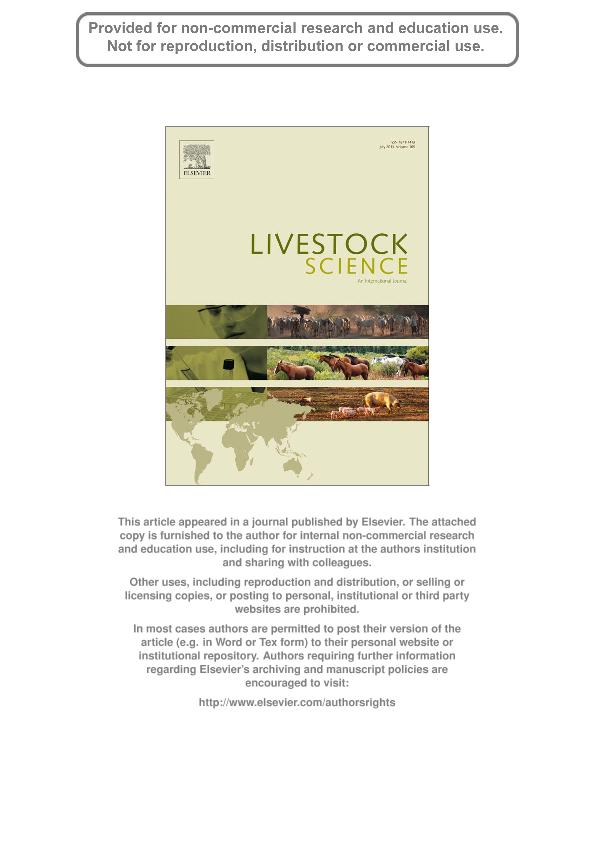Mostrar el registro sencillo del ítem
dc.contributor.author
Piccardi, Mónica Belén

dc.contributor.author
Pipino, D
dc.contributor.author
Bo, Gabriel Amilcar

dc.contributor.author
Balzarini, Monica Graciela

dc.date.available
2018-01-19T14:30:42Z
dc.date.issued
2014-04
dc.identifier.citation
Piccardi, Mónica Belén; Pipino, D; Bo, Gabriel Amilcar; Balzarini, Monica Graciela; Productive and reproductive performance of first lactation purebred Holstein versus Swedish red & white×Holstein in central Argentina; Elsevier Science; Livestock Science; 165; 4-2014; 37-41
dc.identifier.issn
1871-1413
dc.identifier.uri
http://hdl.handle.net/11336/33935
dc.description.abstract
The aim of this work was to compare productive and reproductive performance between pure Holstein (H) and Swedish Red & White×Holstein crossbred (SRB/H) in first lactation dairy cows from the central region of Argentina. This study included 450 lactations from a commercial dairy of central-southern Argentina. The differences in mean daily milk yield, days to first breeding (DFB) and number of services per pregnancy (NS/P) between genotypes were evaluated. A Cox proportional hazard regression model was fitted to evaluate the breed effects on days open (DO) and adjusting by calving season and calving year. Days open were estimated trough survival curves for H breed and SRB/H crossbred using Kaplan–Meier method. Finally, average lactation curves were modeled for each genotype using a non-linear mixed model. Daily milk yield was not significantly different between genotypes. However, the cumulative 305-d yield and peak milk yield for pure H was higher than for SRB/H. Days to first breeding was lower for SRB/H than pure H. The NS/P was higher for pure H than for SRB/H. Regarding DO, SRB/H breed had 1.00–1.71 higher likelihood to become pregnant than pure H. Days open of 50% of pure H was 30 d higher than for SRB/H. The results showed that SRB/H crossbred were superior to pure H in terms of reproductive performance but inferior in terms of productive performance. Further studies may help to determine if the economics of dairying justifies the use of crossbreeding as a herd fertility enhancing tool.
dc.format
application/pdf
dc.language.iso
eng
dc.publisher
Elsevier Science

dc.rights
info:eu-repo/semantics/openAccess
dc.rights.uri
https://creativecommons.org/licenses/by-nc-sa/2.5/ar/
dc.subject
Crossbreeding
dc.subject
Cox Regression
dc.subject
Days Open
dc.subject
Milk Yield
dc.subject.classification
Otras Ciencias Veterinarias

dc.subject.classification
Ciencias Veterinarias

dc.subject.classification
CIENCIAS AGRÍCOLAS

dc.title
Productive and reproductive performance of first lactation purebred Holstein versus Swedish red & white×Holstein in central Argentina
dc.type
info:eu-repo/semantics/article
dc.type
info:ar-repo/semantics/artículo
dc.type
info:eu-repo/semantics/publishedVersion
dc.date.updated
2018-01-18T21:01:44Z
dc.journal.volume
165
dc.journal.pagination
37-41
dc.journal.pais
Países Bajos

dc.journal.ciudad
Amsterdam
dc.description.fil
Fil: Piccardi, Mónica Belén. Consejo Nacional de Investigaciones Científicas y Técnicas; Argentina. Universidad Nacional de Córdoba. Facultad de Cs.exactas Físicas y Naturales. Departamento de Matemáticas. Cátedra de Estadística y Biometria; Argentina
dc.description.fil
Fil: Pipino, D. Agroveterinaria Pipino. Cordoba; Argentina
dc.description.fil
Fil: Bo, Gabriel Amilcar. Instituto de Reproduccion Animal Córdoba; Argentina. Universidad Nacional de Villa María; Argentina
dc.description.fil
Fil: Balzarini, Monica Graciela. Consejo Nacional de Investigaciones Científicas y Técnicas; Argentina. Universidad Nacional de Córdoba. Facultad de Cs.exactas Físicas y Naturales. Departamento de Matemáticas. Cátedra de Estadística y Biometria; Argentina
dc.journal.title
Livestock Science

dc.relation.alternativeid
info:eu-repo/semantics/altIdentifier/doi/http://dx.doi.org/10.1016/j.livsci.2014.04.025
dc.relation.alternativeid
info:eu-repo/semantics/altIdentifier/url/http://www.sciencedirect.com/science/article/pii/S1871141314002261
Archivos asociados
